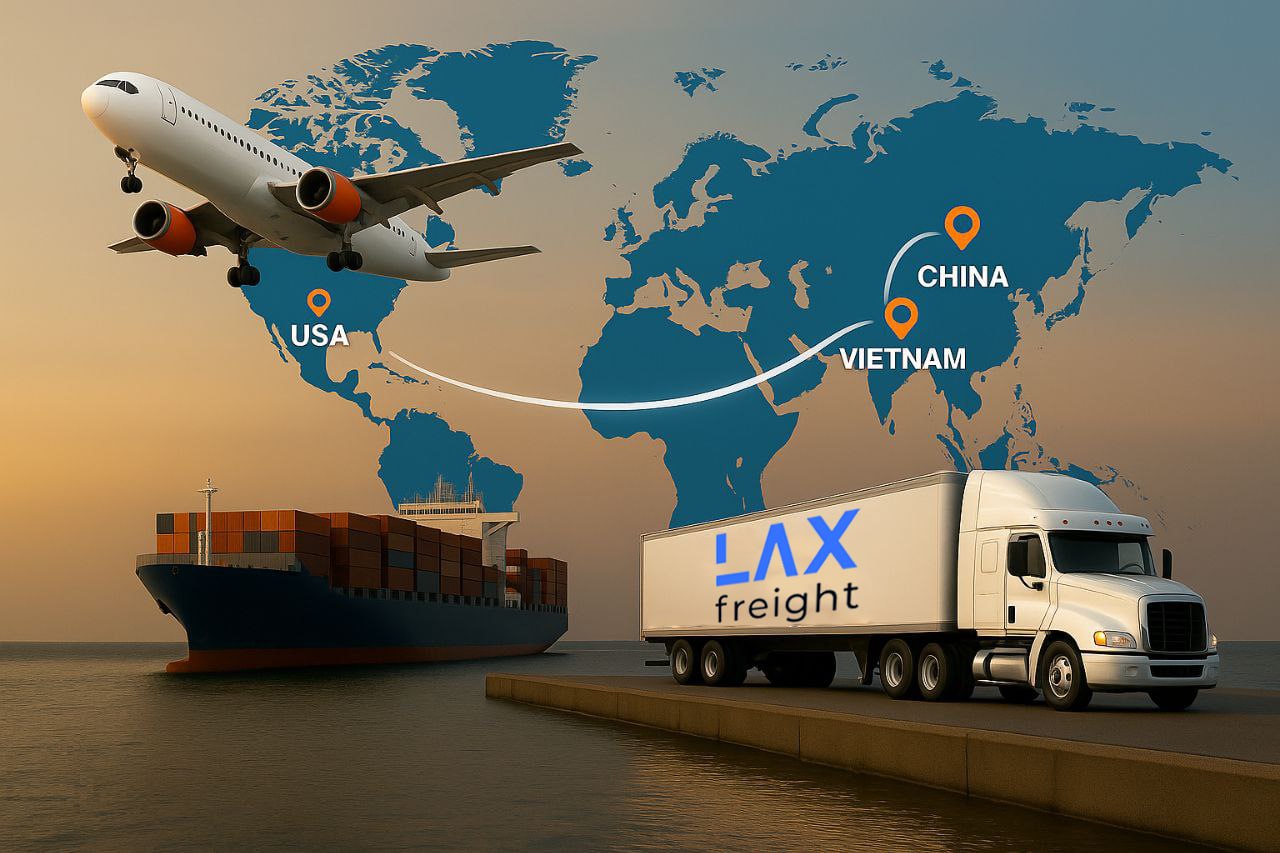Building successful partnerships with third-party logistics providers (3PL) is essential for businesses aiming to streamline supply chain operations, reduce costs, and improve customer satisfaction. As companies face increasing demand for faster delivery, seamless order fulfillment, and efficient reverse logistics, partnering with the right 3PL provider becomes necessary. These providers specialize in managing complex logistics operations, from inventory management and freight shipping to advanced warehouse management systems (WMS), allowing businesses to focus on their core competencies while gaining critical efficiency.
For example, you can consider LAX Freight. Renowned for its tailored logistics solutions and expertise, our team excels in meeting your transportation and supply chain needs. Whether you require innovative technology integration, responsive freight management, or flexible logistics services, LAX Freight ensures your business operates efficiently and competitively. Contact us today to explore how we can elevate your supply chain to new heights!
Different 3PL companies offer different transportation services and specializations. Selecting the right partner is key to achieving operational efficiency. Several factors must be considered, from understanding what services align with your company’s needs to evaluating the scalability and customization of their logistics functions.

Meaning of 3PL Partnership
A 3PL partnership foresees a business arrangement in which a business outsources logistics and supply chain management to a service provider. A third-party logistics company manages specific aspects of logistics, such as transportation, inventory management, warehouse services, and order fulfillment. Companies can leverage the expertise and infrastructure of the logistics provider, ensuring more efficient operations, reducing costs, and enhancing client experience.
Still, the purpose of partnering with a third-party logistics company involves more than outsourcing logistics functions. This also involves outsourcing essential elements of the delivery process. Thus, businesses can gain the capability to scale their operations without large investments in internal infrastructure like warehouses, transportation assets, and management software systems. The rise of e-commerce, growing customer demand for faster delivery times, and increasing complexity in supply chain networks make partnerships with 3PL providers invaluable in the logistics industry.
A 3PL provider manages critical areas such as warehouse management, shipping costs, freight shipping, and order fulfillment, allowing businesses to concentrate on product development, marketing, and consumer experience. Effective management of logistics functions ensures products reach customers at the right time and lower costs.
In addition, 3PL companies provide significant advantages in terms of access to specialized services, including warehouse management software, cutting-edge inventory control systems, and optimized shipping strategies that traditional in—house logistics departments might struggle to implement. Through a 3PL partnership, companies can reduce their transportation expenses and achieve cost control.
While the essential goal of cooperating with a 3PL company is to enhance operational efficiency, the underlying benefit is often cost reduction. A well-executed 3PL partnership streamlines processes, reduces operational burdens, and helps businesses manage risks, leading to tangible logistics cost savings. A third-party logistics provider’s real power lies in its ability to drive operational excellence and efficiency across the supply chain while providing scalable solutions as businesses evolve and grow.
Tips for Developing Long-Term 3PL Partnerships
Building a long-term and fruitful partnership with a third-party logistics provider requires more than selecting the company that meets your logistics needs. This process also requires careful planning, clear goal setting, and continuous collaboration.
Define Goals and Success Criteria
Before signing a 3PL agreement, you must define your goals and expectations. These goals should cover short-term objectives and long-term aspirations. For example, you can begin with short-term goals like optimizing shipping costs, reducing order fulfillment time, or improving inventory management. Further, your goals might involve improving overall client satisfaction, achieving market expansion, or integrating advanced technological systems. Thus, your 3PL partner will be able to scale as your operations grow.
These criteria provide a roadmap for understanding how well the partnership is progressing and whether the 3PL provider’s services meet your business’s needs. At the start of the partnership, clear performance metrics—often key performance indicators (KPIs)—should be outlined.
Defining qualitative and quantitive success criteria, such as reducing logistics expenses by 10%, improving delivery accuracy, or enhancing order fulfillment speed, makes it easier for businesses to track the collaboration’s success and address potential challenges before they lead to serious consequences.
As customer expectations continue to evolve, ensuring your goals include enhancing customer engagement becomes integral. Customers now expect a high level of personalization in their shopping experience and timely, accurate deliveries. Long-term goals could involve building better customer experiences through improved warehouse management systems, inventory control practices, and shipping speed.
Set Measurable KPIs
Once you have established your goals, the next step in ensuring a successful 3PL collaboration is selecting and regularly reviewing the key performance indicators (KPIs). This will evaluate the success of these objectives. KPIs should provide actionable insights into how well logistics operations are functioning. Tracking these KPIs helps organizations stay on course and gives your 3PL provider clear performance benchmarks to meet.
For instance, you can review these examples of essential KPIs.
Order fulfillment. This is the average time for picking, packing, and shipping an order. The faster a company can fulfill orders, its customer satisfaction levels will be better. Rapid order fulfillment services can be crucial, especially for eCommerce fulfillment businesses, where customers demand swift delivery.
Shipping accuracy. Customers have higher expectations than ever about receiving the correct products. Shipping accuracy is measured by the percentage of shipments that arrive without errors or damaged goods. For your 3PL partner, maintaining high accuracy levels reduces returns and enhances the overall customer experience.
Inventory turnover. A key measure of how efficiently inventory is managed within a WMS. By accurately forecasting demand and implementing effective inventory control processes, you minimize excess stock, optimize warehouse space, and avoid stockouts.
On-time delivery rate. Delivery times are crucial for any business. This metric evaluates the percentage of deliveries that occur within the scheduled time. Timely deliveries often correlate directly to customer experience, with delays leading to frustration and dissatisfaction.
Logistics costs. Tracking the direct costs associated with logistics is fundamental to maintaining profitability. By regularly reviewing these costs, including delivery costs and warehouse management, businesses can make more informed decisions about controlling or reducing logistics spending.
Effective KPIs require regular assessment. Businesses and third-party logistics providers should actively collaborate to rectify any performance KPI that fails to meet set benchmarks. Rising shipping expenses, for example, could point to inefficiencies in route management or packaging.
Ensure Effective Technology Uses
Technology is one of the biggest drivers of efficiency in modern logistics. Their use enables more streamlined processes and reduces operational bottlenecks. A 3PL provider with advanced solutions can significantly improve areas like inventory management, warehouse operations, and delivery services.
For instance, automated technologies enhance warehouse efficiency by optimizing inventory storage, routing shipments, and processing orders.
When selecting a 3PL provider, companies should prioritize providers with up-to-date systems. For instance, innovative warehouse management software (WMS) allows businesses to monitor inventory, improve shipping routes, and streamline the pick-and-pack process. This level of automation also ensures that customers get timely and accurate deliveries while your 3PL partner enjoys efficiency gains.
Implementing advanced technologies into the logistics chain provides a range of benefits, such as improved supply chain visibility and faster response in meeting market demands. In particular, tracking systems that allow businesses and customers to see the real-time location of shipments help maintain trust and transparency, which is vital for customer satisfaction and long-term strategic goals.
Incorporating AI-driven demand forecasting, dynamic routing, and predictive analytics systems in collaboration with 3PL partners enables continuous improvement in operational efficiency, reduces fulfillment delays, and enhances resource allocation.
Identify Preferred Communication Methods
A successful 3PL cooperation thrives on strong communication. Frequent communication with your logistics partner ensures smooth day-to-day operations and promptly addresses potential issues. Communication extends beyond simple email correspondence—having scheduled check-ins to review performance, share insights, and identify problem areas is equally essential.
Establish preferred communication channels with your 3PL provider early in the relationship. Determine if regular phone calls, video meetings, or cloud-based collaboration tools work best for ongoing discussions about inventory control, logistics functions, or scheduling issues.
Reliable real-time communication methods also help resolve small issues before they escalate. If delivery schedules need to be changed, inventory issues arise, or an order fulfillment issue arises, quickly addressing them through rapid communication helps limit downtime and operational setbacks. Technology solutions like real-time shipment tracking, live reporting, and customer service platforms also reduce gaps in communication, making it easier to stay up-to-date with order statuses and fulfillment processes.
Moreover, it’s important to understand what conflict resolution may involve within the 3PL collaboration. Establishing clear methods of communicating challenges is paramount in managing these situations without damaging the relationship between the business and the provider.
Compare 3PL Companies
When looking to establish a long-term 3PL partnership, a thorough comparison of third-party logistics is needed. Different providers offer diverse options on the table, depending on factors such as industry expertise, technological integration, and specialized services. Comparing providers across these factors will ensure you find the best fit for your needs.
You can follow these factors to evaluate different 3PL providers for a suitable choice.
Range of logistics services. It’s important to identify the specific services each company offers. Check their specialization in functions you need, such as cargo delivery, warehouse management, or inventory management. In addition, you should assess their ability to handle your current and future logistics needs.
Network coverage. Check if the 3PL provider operates in regions critical to your operations for a successful partnership. Consider warehouse locations’ number and strategic placement and their impact on delivery times and order efficiency.
Scalability and growth potential. Evaluate whether their providers can scale with your business as it grows. Look for capabilities such as increased order fulfillment capacity, expanded inventory storage, and strategies to help reduce shipping costs when entering new markets.
Unique features and specializations. Before signing a contract, ask whether the company offers specialized solutions like customized distribution services or advanced supply chain visibility tools. Some 3PL companies may provide unique features like tracking technology or a streamlined delivery process.
Technology and innovation. Assess their use of technology, including warehouse management and tools for real-time tracking or forecasting. Look for providers with robust supply chain operations visibility and the ability to integrate with your existing software.
Customer-centric customization. Evaluate how their fulfillment company aligns with your customer expectations and whether they can enhance client experience through tailored services.
Experience and track record. Research their expertise in handling logistics for your industry. In addition, look for a proven track record and experience in delivering results for businesses similar to yours.
Cost efficiency. Compare pricing structures and potential cost savings of different logistics providers. Analyze how well they can manage costs related to freight hauling, warehouse management, and overall supply chain expenses while maintaining service quality.
Communication and support. Evaluate their responsiveness and communication channels. Ensure they provide clear updates on order statuses, logistics expenses, and potential disruptions.
Scalability in reverse logistics. Review their policies for handling returns and reverse logistics management to ensure efficiency and customer satisfaction in case of product issues.
State the Terms and Conditions of the Contract
A formal contract outlining the terms and conditions of the 33PL cooperation is one of the most important tools for managing the relationship. This document should define the scope of the logistics services, from inventory management to delivery, to ensure there is no confusion about what both parties agreed to.
The agreement should include clear terms regarding performance and consequences if KPIs are not met. For example, if on-time delivery rates are below an agreed percentage, there should be clauses on corrective actions and potential penalties. Laying out the expectations on both sides makes dispute resolution easier and reduces confusion.
While defining logistics costs and payment structures is a straightforward aspect of contract formation, remember that clauses deal with confidentiality and intellectual property. After all, you’re entrusting a third party with your inventory management, product handling, and supply chain processes. Ensuring non-disclosure agreements (NDAs) protect both business interests can be critical.
Conclusion
Choosing the most suitable 3PL provider is pivotal for optimizing logistics operations and improving supply chain management. Companies can make well-informed decisions by evaluating providers based on their range of logistics services, ability to share expertise in leveraging advanced technology solutions, and and track record of enhancing customer satisfaction.
A strong 3PL cooperation also helps companies reduce costs, expand market reach, and achieve lasting business growth. As your logistics demands evolve, so should the collaboration with your third-party logistics partner, ensuring their services and your goals and contributing to sustainable success. With the right provider and a focus on streamlined oeprations and customer-centric strategies, businesses can achieve measurable performance improvements and maintain a competitive edge in today’s dynamic marketplace.


